Electrospun Nanofibre Air Filters for Particles and Gaseous Pollutants
Abstract
:1. Introduction
2. Materials and Methods
2.1. Materials
2.2. Fabrication of Electrospun Nanofibre Filters
2.3. Nanofibre Characterisation
2.4. Investigation of Filtration Performance
3. Results and Discussion
3.1. Electrospinning
3.2. Nanofibre Characterisation
3.2.1. Scanning Electron Microscopy, Fibre Diameter and BET Analysis
3.2.2. FTIR and Raman Spectroscopy Analysis
3.2.3. Thermogravimetric Analysis
3.3. Filtration Performance
3.3.1. Pressure Drop
3.3.2. Particle Filtration Efficiency
3.3.3. Toluene Removal
4. Conclusions
Author Contributions
Funding
Acknowledgments
Conflicts of Interest
Abbreviations
| AC | Activated Charcoal |
| BET | Brunauer–Emmett–Teller method |
| BJH | Barrett–Joyner–Halenda method |
| FTIR | Fourier Transform Infrared |
| HEPA | High Efficiency Particulate Air |
| HVAC | Heating, Ventilation and Air Conditioning |
| PVA | Polyvinyl Alcohol |
| SEM | Scanning Electron Microscopy |
| SSA | Specific Surface Area |
| TCD | Tip-to-Collector Distance |
| TGA | Thermogravimetric Analysis |
| TVOCs | Total Volatile Organic Compounds |
| VOCs | Volatile Organic Compounds |
References
- Lelieveld, J.; Pozzer, A.; Pöschl, U.; Fnais, M.; Haines, A.; Münzel, T. Loss of life expectancy from air pollution compared to other risk factors: A worldwide perspective. Cardiovasc. Res. 2020, 116, 1910–1917. [Google Scholar] [CrossRef] [PubMed]
- World Health Organization. Available online: https://www.who.int/data/gho (accessed on 11 January 2021).
- Mills, N.L.; Donaldson, K.; Hadoke, P.W.; Boon, N.A.; MacNee, W.; Cassee, F.R.; Sandström, T.; Blomberg, A.; Newby, D.E. Adverse cardiovascular effects of air pollution. Nat. Clin. Pract. Cardiovasc. Med. 2009, 6, 36–44. [Google Scholar] [CrossRef] [PubMed]
- Brunekreef, B.; Holgate, S.T. Air pollution and health. Lancet 2002, 360, 1233–1242. [Google Scholar] [CrossRef]
- Katsouyanni, K.; Touloumi, G.; Samoli, E.; Gryparis, A.; Le Tertre, A.; Monopolis, Y.; Rossi, G.; Zmirou, D.; Ballester, F.; Boumghar, A.; et al. Confounding and effect modification in the short-term effects of ambient particles on total mortality: Results from 29 European cities within the APHEA2 project. Epidemiology 2001, 12, 521–531. [Google Scholar] [CrossRef] [Green Version]
- Pope, C.A.; Dockery, D.W. Health effects of fine particulate air pollution: Lines that connect. J. Air Waste Manag. Assoc. 2006, 56, 709–742. [Google Scholar] [CrossRef]
- Fisk, W.J. Health benefits of particle filtration. Indoor Air 2013, 23, 357–368. [Google Scholar] [CrossRef]
- Mannucci, P.M.; Harari, S.; Martinelli, I.; Franchini, M. Effects on health of air pollution: A narrative review. Intern. Emerg. Med. 2015, 10, 657–662. [Google Scholar] [CrossRef] [PubMed]
- Khan, F.I.; Ghoshal, A.K. Removal of Volatic Organic Compounds from polluted air. J. Loss Prev. Process Ind. 2000, 13, 527–545. [Google Scholar] [CrossRef]
- Mamaghani, A.H.; Haghighat, F.; Lee, C.S. Photocatalytic oxidation technology for indoor environment air purification: The state-of-the-art. Appl. Catal. B Environ. 2017, 203, 247–269. [Google Scholar] [CrossRef]
- Zaatari, M.; Novoselac, A.; Siegel, J. The relationship between filter pressure drop, indoor air quality, and energy consumption in rooftop HVAC units. Build. Environ. 2014, 73, 151–161. [Google Scholar] [CrossRef]
- Sundarrajan, S.; Tan, K.L.; Lim, S.H.; Ramakrishna, S. Electrospun nanofibers for air filtration applications. Procedia Eng. 2014, 75, 159–163. [Google Scholar] [CrossRef] [Green Version]
- Li, P.; Wang, C.; Zhang, Y.; Wei, F. Air filtration in the free molecular flow regime: A review of high-efficiency particulate air filters based on Carbon Nanotubes. Small 2014, 10, 4543–4561. [Google Scholar] [CrossRef] [PubMed]
- Zhao, X.; Wang, S.; Yin, X.; Yu, J.; Ding, B. Slip-Effect Functional Air Filter for Efficient Purification of PM 2.5. Sci. Rep. 2016, 6, 1–11. [Google Scholar] [CrossRef]
- Kadam, V.V.; Wang, L.; Padhye, R. Electrospun nanofibre materials to filter air pollutants—A review. J. Ind. Text. 2018, 47, 2253–2280. [Google Scholar] [CrossRef]
- Zhu, M.; Han, J.; Wang, F.; Shao, W.; Xiong, R.; Zhang, Q.; Pan, H.; Yang, Y.; Samal, S.K.; Zhang, F.; et al. Electrospun Nanofibers Membranes for Effective Air Filtration. Macromol. Mater. Eng. 2017, 302. [Google Scholar] [CrossRef]
- Li, D.; Xia, Y. Electrospinning of nanofibers: Reinventing the wheel? Adv. Mater. 2004, 16, 1151–1170. [Google Scholar] [CrossRef]
- Scholten, E.; Bromberg, L.; Rutledge, G.C.; Hatton, T.A. Electrospun polyurethane fibers for absorption of volatile organic compounds from air. ACS Appl. Mater. Interfaces 2011, 3, 3902–3909. [Google Scholar] [CrossRef] [Green Version]
- Park, J.Y.; Lee, I.H. Characterization and Morphology of Prepared Titanium Dioxide Nanofibers by Electrospinning. J. Nanosci. Nanotechnol. 2010, 10, 3402–3405. [Google Scholar] [CrossRef] [PubMed]
- Wan, H.; Wang, N.; Yang, J.; Si, Y.; Chen, K.; Ding, B.; Sun, G.; El-Newehy, M.; Al-Deyab, S.S.; Yu, J. Hierarchically structured polysulfone/titania fibrous membranes with enhanced air filtration performance. J. Colloid Interface Sci. 2014, 417, 18–26. [Google Scholar] [CrossRef]
- Lee, K.J.; Shiratori, N.; Lee, G.H.; Miyawaki, J.; Mochida, I.; Yoon, S.H.; Jang, J. Activated carbon nanofiber produced from electrospun polyacrylonitrile nanofiber as a highly efficient formaldehyde adsorbent. Carbon 2010, 48, 4248–4255. [Google Scholar] [CrossRef]
- Wang, H.; Zheng, G.F.; Wang, X.; Sun, D.H. Study on the air filtration performance of nanofibrous membranes compared with conventional fibrous filters. In Proceedings of the 2010 IEEE 5th International Conference on Nano/Micro Engineered and Molecular Systems, NEMS 2010, Xiamen, China, 20–23 January 2010; pp. 387–390. [Google Scholar] [CrossRef]
- Chuang, Y.H.; Hong, G.B.; Chang, C.T. Study on particulates and volatile organic compounds removal with TiO2nonwoven filter prepared by electrospinning. J. Air Waste Manag. Assoc. 2014, 64, 738–742. [Google Scholar] [CrossRef]
- Givehchi, R.; Li, Q.; Tan, Z. Quality factors of PVA nanofibrous filters for airborne particles in the size range of 10–125 nm. Fuel 2016, 181, 1273–1280. [Google Scholar] [CrossRef]
- Oh, G.Y.; Ju, Y.W.; Jung, H.R.; Lee, W.J. Preparation of the novel manganese-embedded PAN-based activated carbon nanofibers by electrospinning and their toluene adsorption. J. Anal. Appl. Pyrolysis 2008, 81, 211–217. [Google Scholar] [CrossRef]
- Ju, Y.W.; Oh, G.Y. Behavior of toluene adsorption on activated carbon nanofibers prepared by electrospinning of a polyacrylonitrile-cellulose acetate blending solution. Chem. Eng. J. 2017, 34, 2731–2737. [Google Scholar] [CrossRef]
- Wang, M.X.; Huang, Z.H.; Shimohara, T.; Kang, F.; Liang, K. NO removal by electrospun porous carbon nanofibers at room temperature. Chem. Eng. J. 2011, 170, 505–511. [Google Scholar] [CrossRef]
- Xia, T.; Bian, Y.; Zhang, L.; Chen, C. Relationship between pressure drop and face velocity for electrospun nanofiber filters. Energy Build. 2018, 158, 987–999. [Google Scholar] [CrossRef]
- Subbiah, T.; Bhat, G.S.; Tock, R.W.; Parameswaran, S.; Ramkumar, S.S. Electrospinning of nanofibers. J. Appl. Polym. Sci. 2005, 96, 557–569. [Google Scholar] [CrossRef]
- Deitzel, J.M.; Kleinmeyer, J.D.; Harris, D.; Beck Tan, N.C. The effect of processing variables on the morphology of electrospun. Polymer 2001, 42, 261–272. [Google Scholar] [CrossRef]
- Lu, J.D.; Xue, J. Poisoning: Kinetics to Therapeutics. In Critical Care Nephrology, 3rd ed.; Elsevier Inc.: Amsterdam, The Netherlands, 2019; pp. 600–629. [Google Scholar] [CrossRef]
- Wang, Y.; Zhong, M.; Chen, F.; Yang, J. Visible light photocatalytic activity of TiO2/D-PVA for MO degradation. Appl. Catal. B Environ. 2009, 90, 249–254. [Google Scholar] [CrossRef]
- Coates, J. Interpretation of Infrared Spectra, A Practical Approach. In Encyclopedia of Analytical Chemistry; Meyers, R.A., Ed.; John Wiley and Sons Ltd.: Hoboken, NJ, USA, 2000. [Google Scholar]
- Mansur, H.S.; Sadahira, C.M.; Souza, A.N.; Mansur, A.A. FTIR spectroscopy characterization of poly (vinyl alcohol) hydrogel with different hydrolysis degree and chemically crosslinked with glutaraldehyde. Mater. Sci. Eng. C 2008, 28, 539–548. [Google Scholar] [CrossRef]
- Kharazmi, A.; Faraji, N.; Hussin, R.M.; Saion, E.; Yunus, W.M.M.; Behzad, K. Structural, optical, opto-thermal and thermal properties of ZnS-PVA nanofluids synthesized through a radiolytic approach. Beilstein J. Nanotechnol. 2015, 6, 529–536. [Google Scholar] [CrossRef] [PubMed] [Green Version]
- Bhat, N.V.; Nate, M.M.; Kurup, M.B.; Bambole, V.A.; Sabharwal, S. Effect of γ-radiation on the structure and morphology of polyvinyl alcohol films. Nucl. Instrum. Methods Phys. Res. Sect. B Beam Interact. Mater. Atoms 2005, 237, 585–592. [Google Scholar] [CrossRef]
- Elashmawi, I.S.; Hakeem, N.A.; Selim, M.S. Optimization and spectroscopic studies of CdS/poly(vinyl alcohol) nanocomposites. Mater. Chem. Phys. 2009, 115, 132–135. [Google Scholar] [CrossRef]
- Shi, Y.; Xiong, D.; Li, J.; Wang, K.; Wang, N. In situ repair of graphene defects and enhancement of its reinforcement effect in polyvinyl alcohol hydrogels. RSC Adv. 2017, 7, 1045–1055. [Google Scholar] [CrossRef] [Green Version]
- Ferrari, A.C.; Meyer, J.C.; Scardaci, V.; Casiraghi, C.; Lazzeri, M.; Mauri, F.; Piscanec, S.; Jiang, D.; Novoselov, K.S.; Roth, S.; et al. Raman spectrum of graphene and graphene layers. Phys. Rev. Lett. 2006, 97, 1–4. [Google Scholar] [CrossRef] [Green Version]
- Surmacki, J.; Wroński, P.; Szadkowska-Nicze, M.; Abramczyk, H. Raman spectroscopy of visible-light photocatalyst—Nitrogen-doped titanium dioxide generated by irradiation with electron beam. Chem. Phys. Lett. 2013, 566, 54–59. [Google Scholar] [CrossRef]
- Balachandran, U.; Eror, N.G. Raman spectra of titanium dioxide. J. Solid State Chem. 1982, 42, 276–282. [Google Scholar] [CrossRef]
- Ding, W.; Wei, S.; Zhu, J.; Chen, X.; Rutman, D.; Guo, Z. Manipulated electrospun PVA nanofibers with inexpensive salts. Macromol. Mater. Eng. 2010, 295, 958–965. [Google Scholar] [CrossRef]
- Kim, G.M.; Asran, A.S.; Michler, G.H.; Simon, P.; Kim, J.S. Electrospun PVA/HAp nanocomposite nanofibers: Biomimetics of mineralized hard tissues at a lower level of complexity. Bioinspir. Biomimetics 2008, 3. [Google Scholar] [CrossRef]
- Mancin, S.; Zilio, C.; Cavallini, A.; Rossetto, L. Pressure drop during air flow in aluminum foams. Int. J. Heat Mass Transf. 2010, 53, 3121–3130. [Google Scholar] [CrossRef]
- Su, J.; Yang, G.; Cheng, C.; Huang, C.; Xu, H.; Ke, Q. Hierarchically structured TiO2/PAN nanofibrous membranes for high-efficiency air filtration and toluene degradation. J. Colloid Interface Sci. 2017, 507, 386–396. [Google Scholar] [CrossRef] [PubMed]
- Bortolassi, A.C.C.; Guerra, V.G.; Aguiar, M.L.; Soussan, L.; Cornu, D.; Miele, P.; Bechelany, M. Composites based on nanoparticle and pan electrospun nanofiber membranes for air filtration and bacterial removal. Nanomaterials 2019, 9, 1740. [Google Scholar] [CrossRef] [Green Version]
- Elkamhawy, A.; Jang, C.M. Performance evaluation of hybrid air purification system with vegetation soil and electrostatic precipitator filters. Sustainability 2020, 12, 5428. [Google Scholar] [CrossRef]
- Ollier, R.; Pérez, C.; Alvarez, V. Effect of Relative Humidity on the Mechanical Properties of Micro and Nanocomposites of Polyvinyl Alcohol. Procedia Mater. Sci. 2012, 1, 499–505. [Google Scholar] [CrossRef] [Green Version]
- Yu, W.; In ‘T Veld, M.; Bossi, R.; Ateia, M.; Tobler, D.; Feilberg, A.; Bovet, N.; Johnson, M.S. Formation of formaldehyde and other byproducts by TiO2 photocatalyst materials. Sustainability 2021, 13, 4821. [Google Scholar] [CrossRef]
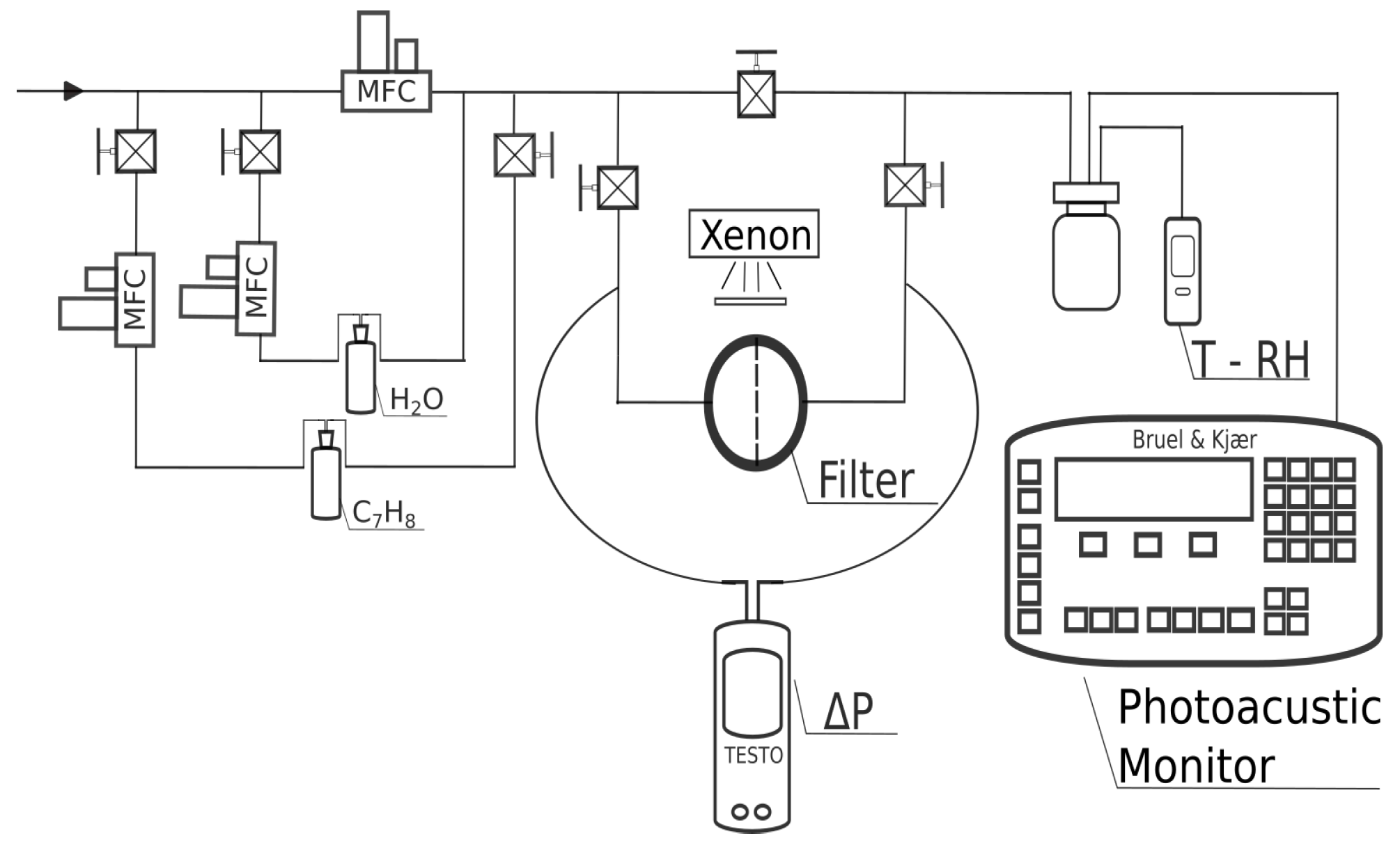
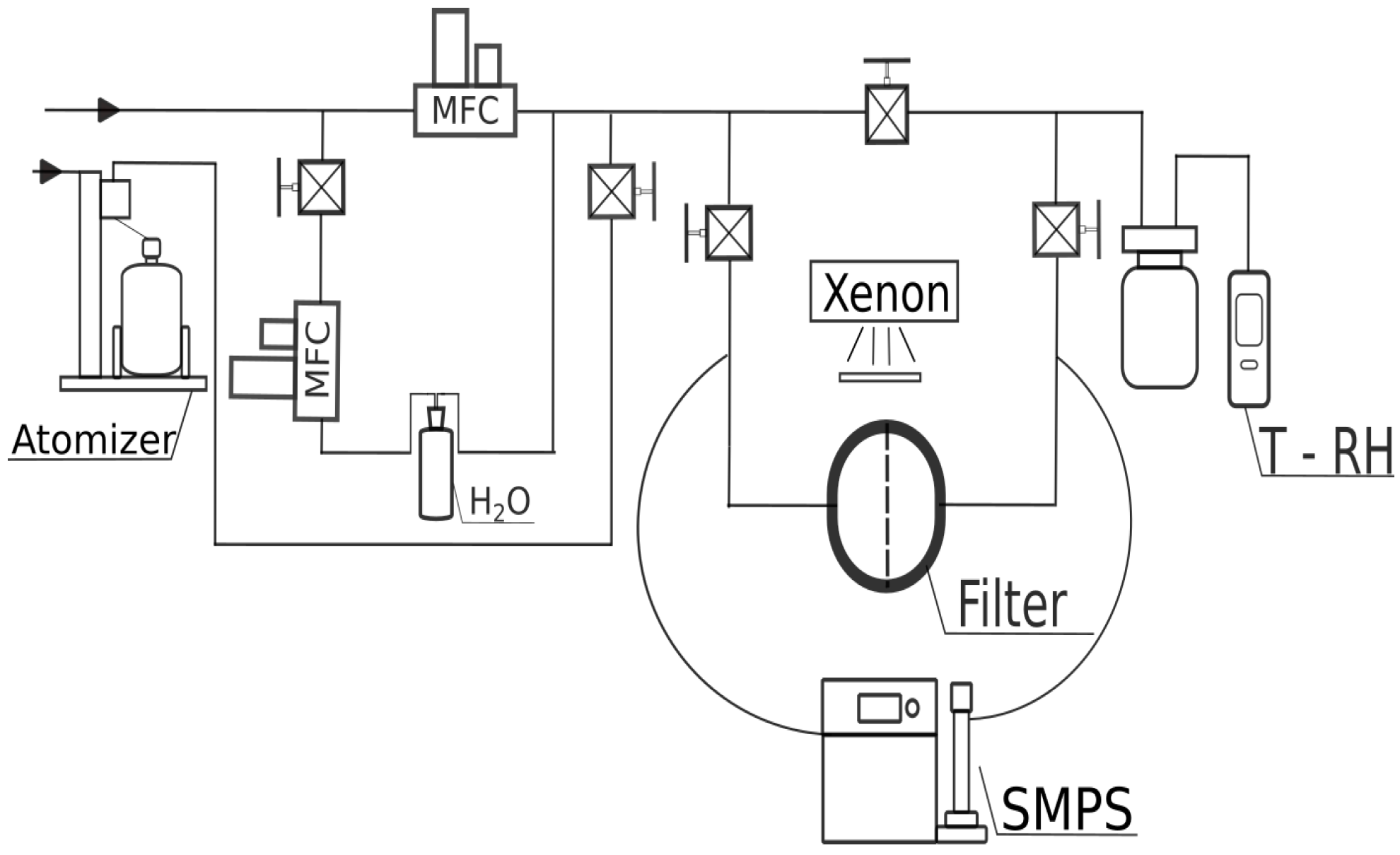
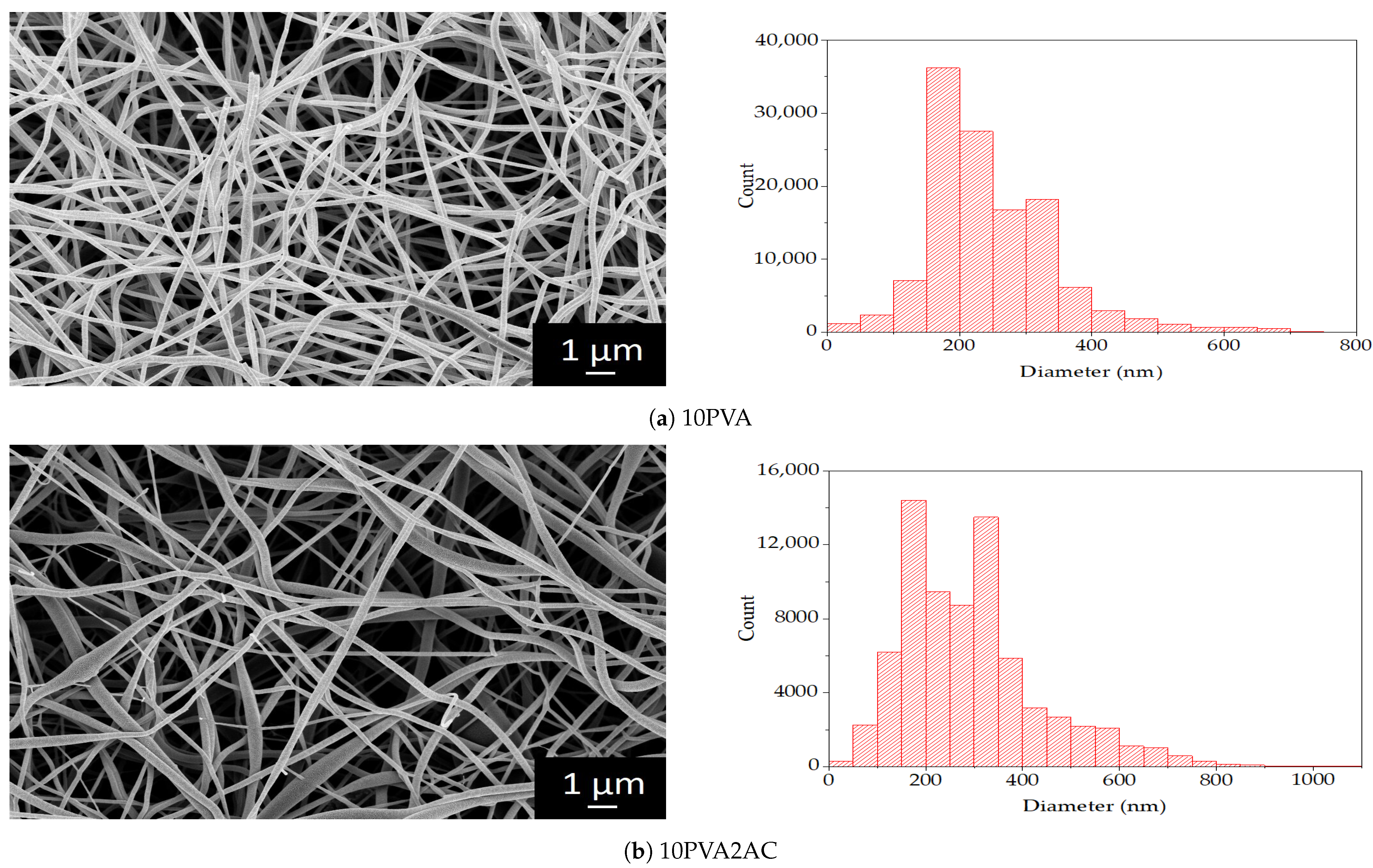
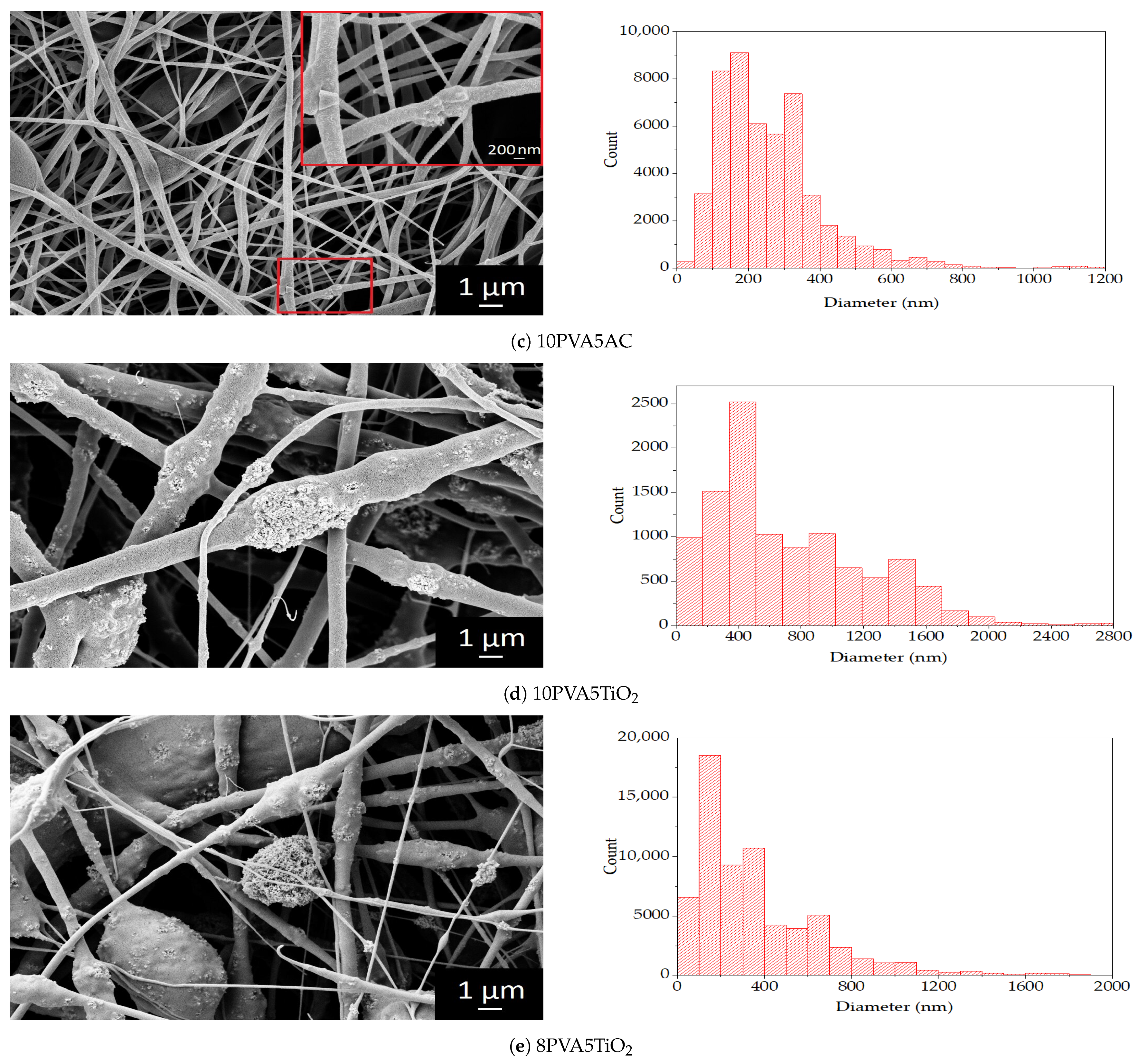
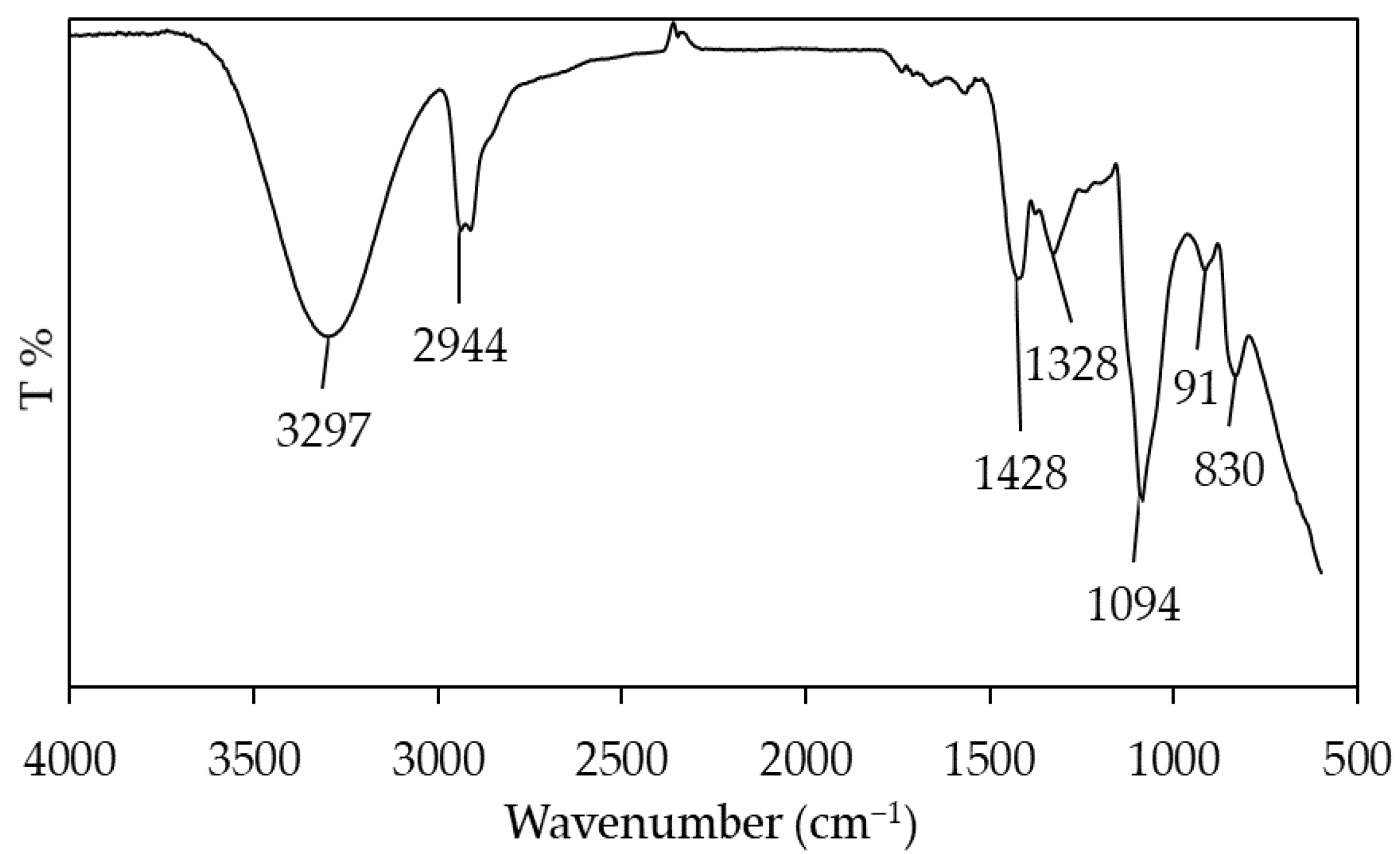
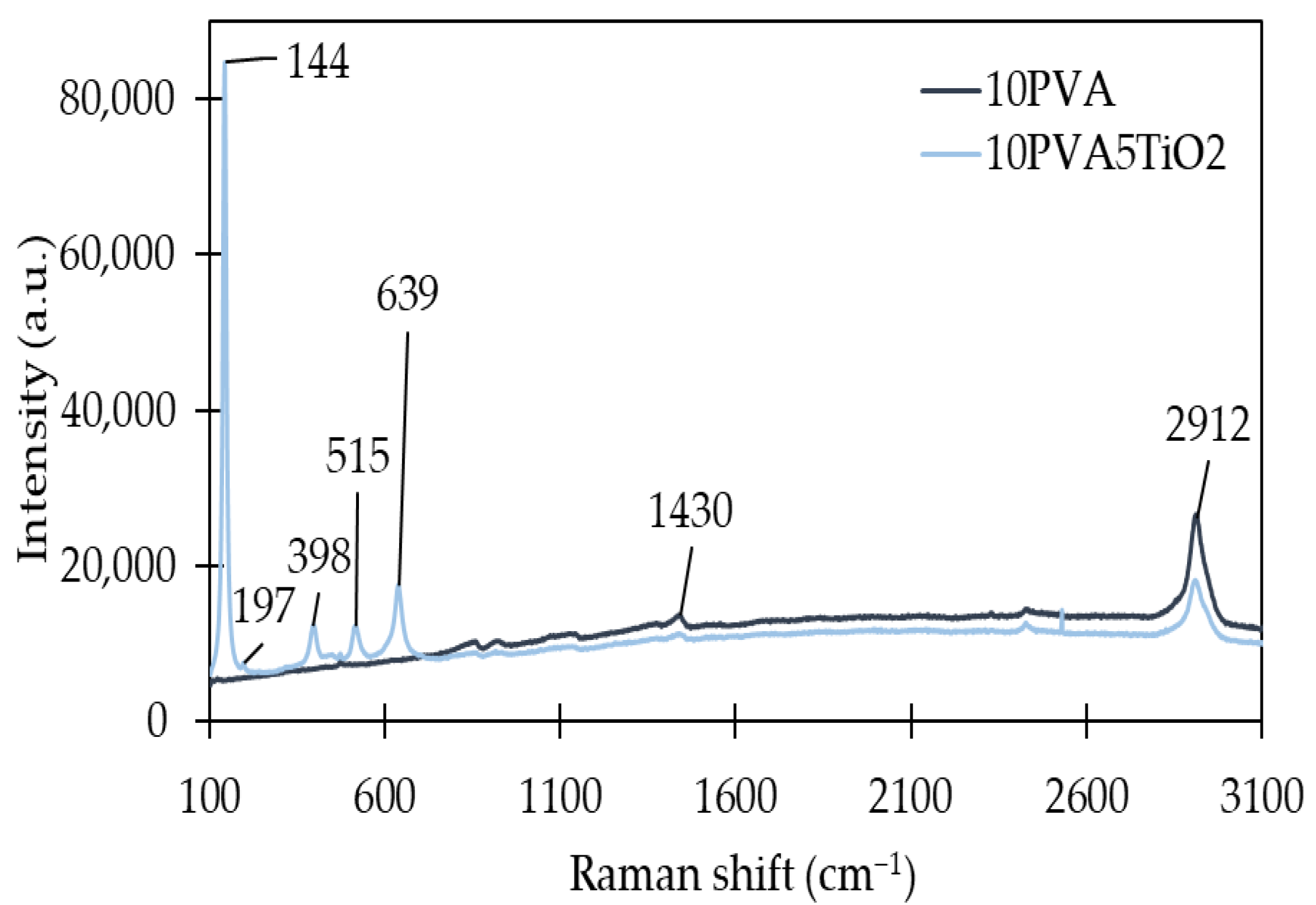
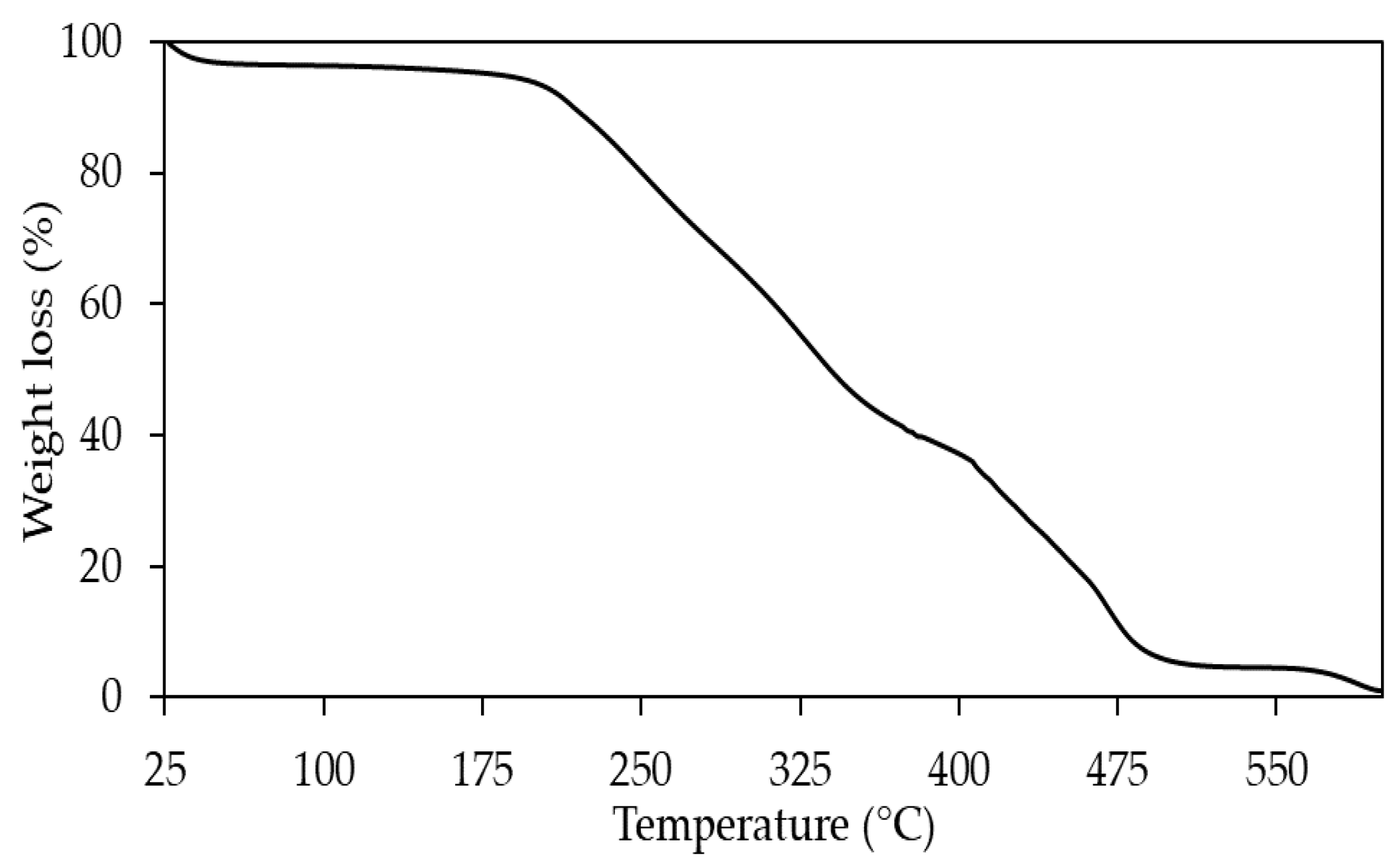
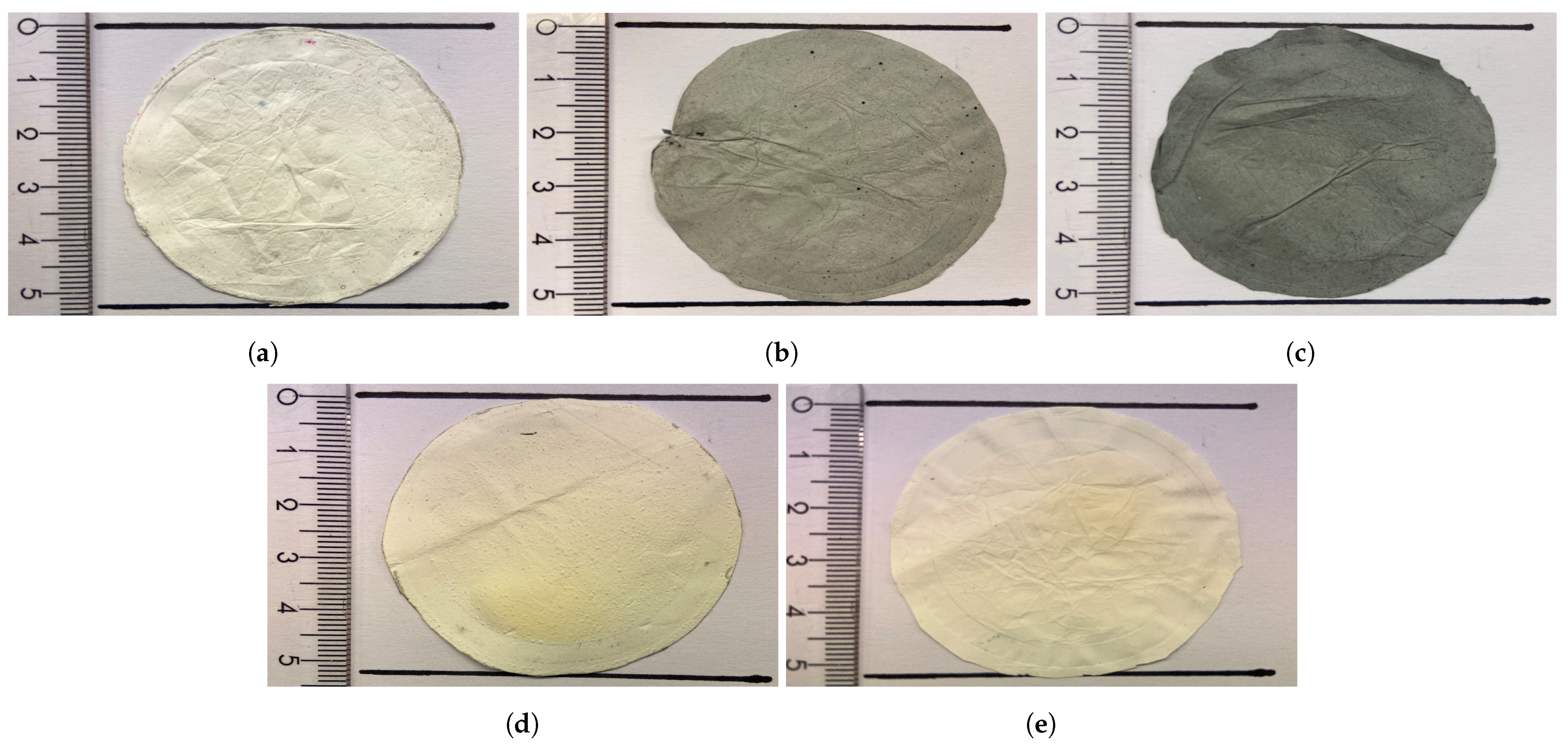
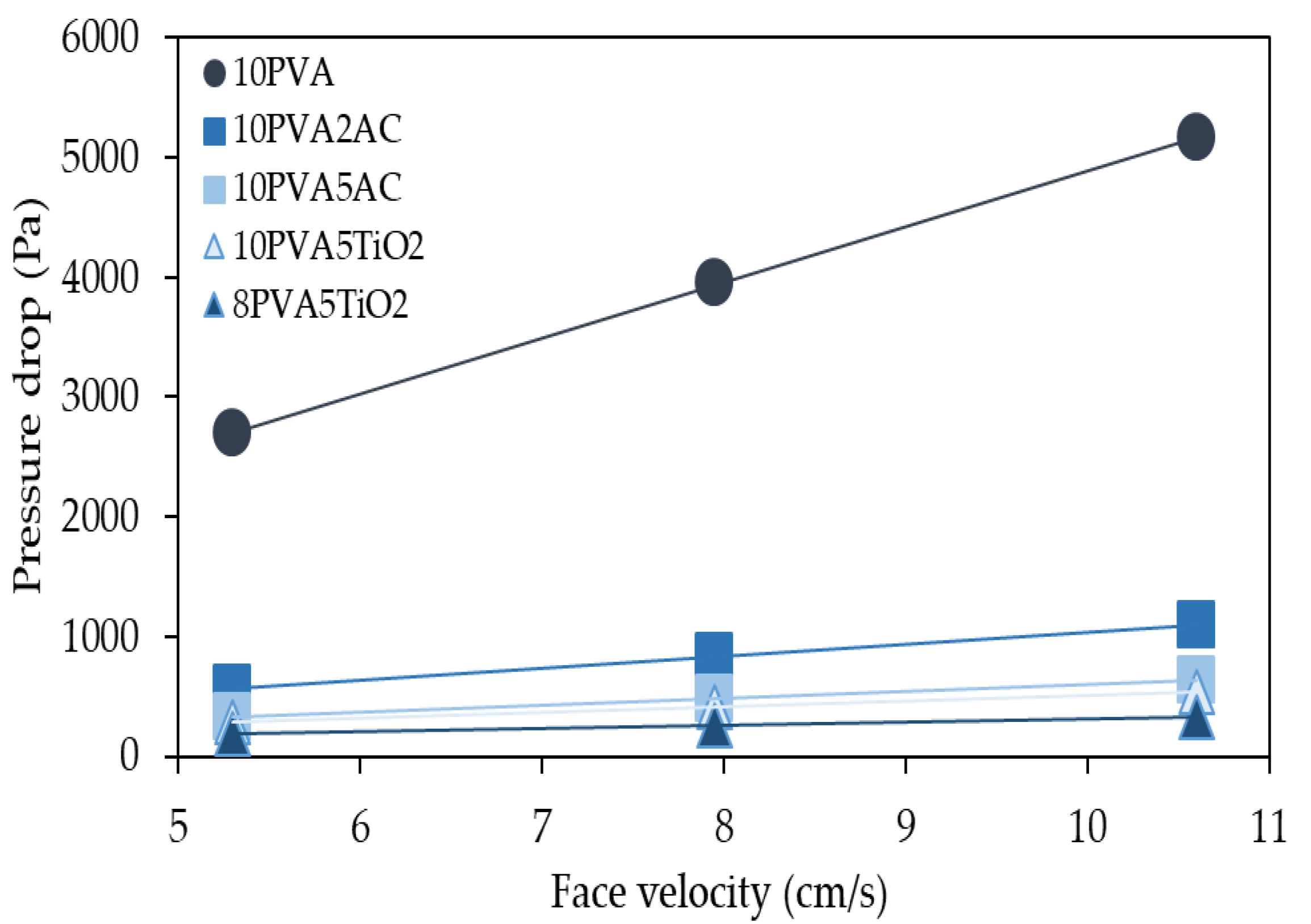
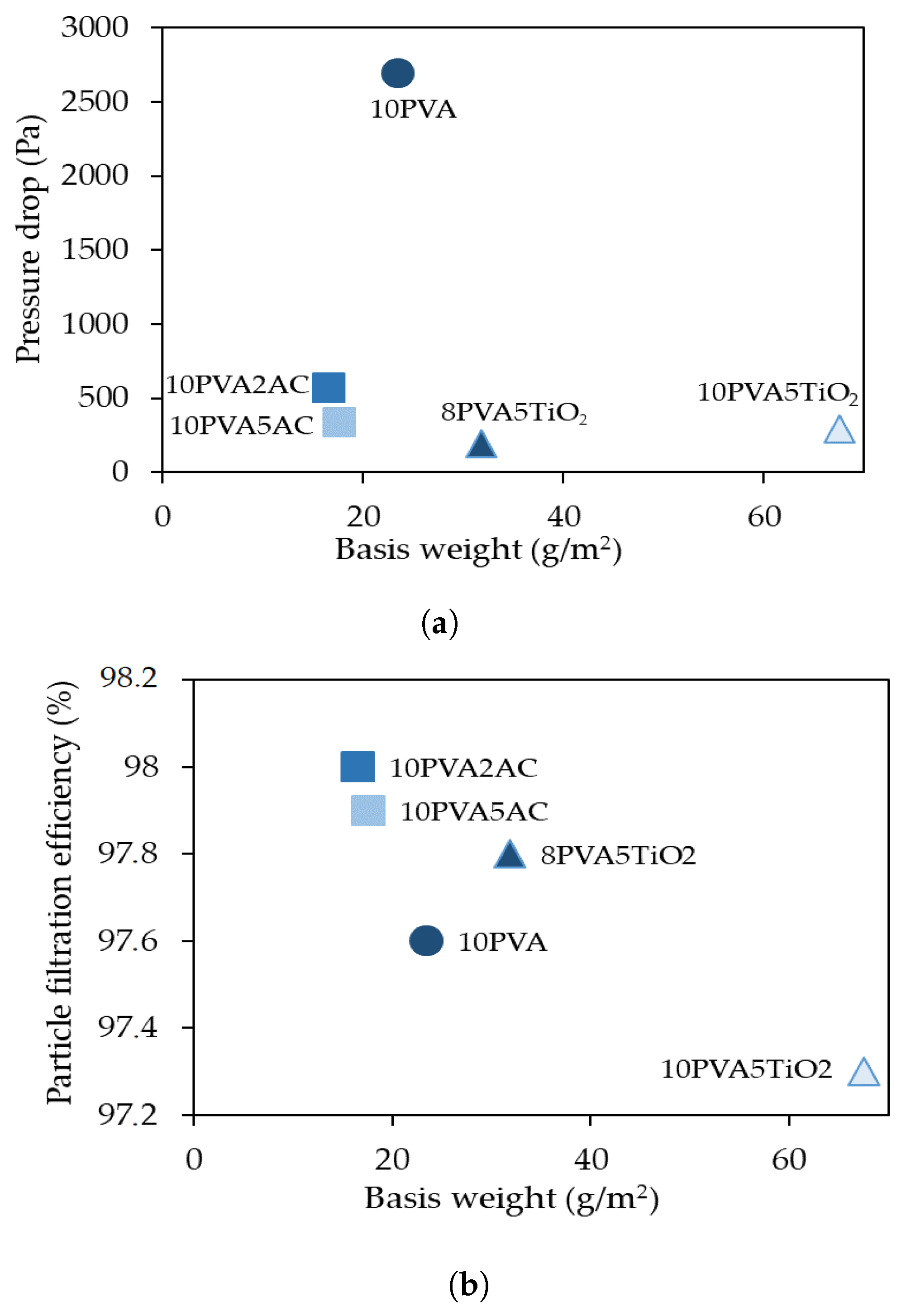
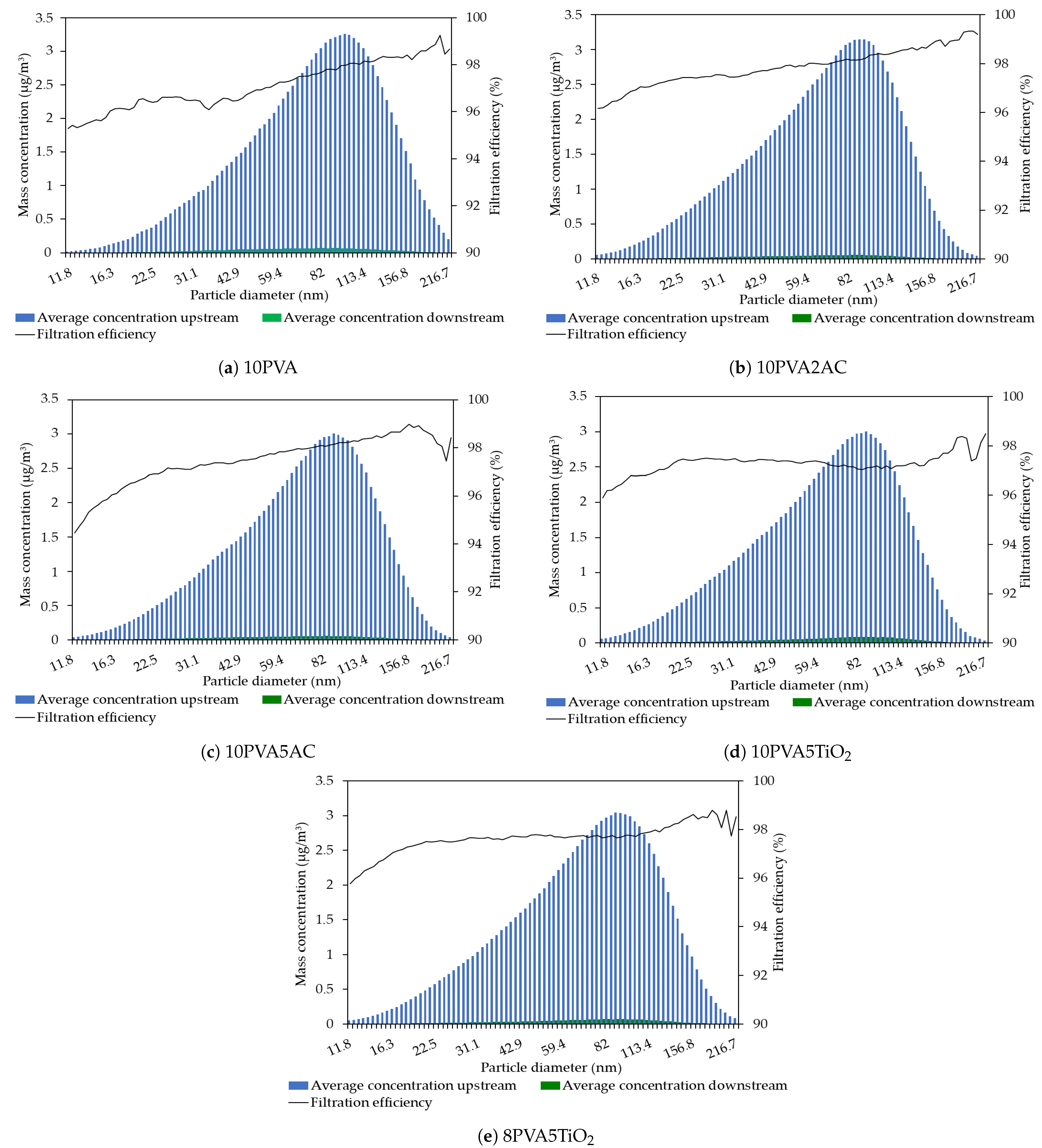
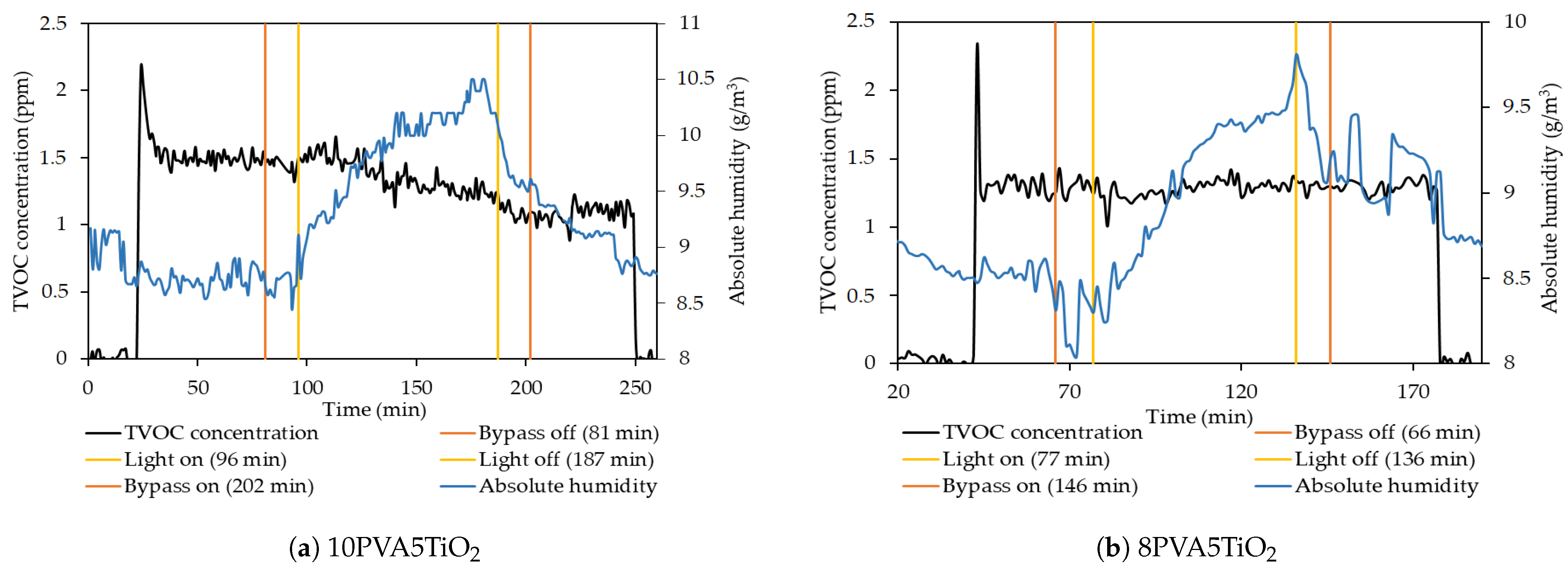
| 10PVA | 10PVA2AC | 10PVA5AC | 10PVA5TiO | 8PVA5TiO | |
|---|---|---|---|---|---|
| Solution | PVA 10 w/v% | PVA 10 w/v% | PVA 10 w/v% | PVA 10 w/v% | PVA 8 w/v% |
| AC 2 w/v% | AC 5 w/v% | TiO 5 w/v% | TiO 5 w/v% | ||
| PVA (g) | 5 | 5 | 5 | 5 | 4 |
| HO (mL) | 50 | 40 | 40 | 35 | 35 |
| Etanol (mL) | - | 10 | 10 | 15 | 15 |
| AC (g) | - | 1 | 2.5 | - | - |
| TiO (g) | - | - | - | 2.5 | 2.5 |
| TCD (cm) | 16.5 | 16 | 16 | 19.5 | 16 |
| Voltage (kV) | 20.3–25.7 | 13.5 | 13.5 | 13.5–16.5 | 11.1 |
| Feed rate (mL/h) | 0.23 | 0.12 | 0.12 | 0.12 | 1 |
| Filter | Fibre Average | STD | Basis Weight | SSA | Average Pore | Total Pore |
|---|---|---|---|---|---|---|
| Diameter | Diameter | Volume | ||||
| (µm) | (µm) | (g/m) | (m/g) | (Å) | (cm/g) | |
| 10PVA | 0.213 | 0.027 | 23.5 | 7.910 | 30.16 | 5.965 × 10 |
| 10PVA2AC | 0.283 | 0.047 | 16.6 | 8.519 | 41.47 | 8.889 × 10 * |
| 10PVA5AC | 0.264 | 0.04 | 17.6 | 17.43 | 31.26 | 1.362 × 10 |
| 10PVA5TiO | 0.430 | 0.083 | 67.6 | 1.434 | 32.48 | 1.165 × 10 |
| 8PVA5TiO | 0.301 | 0.055 | 31.8 | 2.525 | 40.67 | 2.568 × 10 |
| 10PVA | 10PVA2AC | 10PVA5AC | 10PVA5TiO | 8PVA5TiO | |
|---|---|---|---|---|---|
| Total filtration efficiency (%) | 97.6 | 98.0 | 97.9 | 97.3 | 97.8 |
Publisher’s Note: MDPI stays neutral with regard to jurisdictional claims in published maps and institutional affiliations. |
© 2021 by the authors. Licensee MDPI, Basel, Switzerland. This article is an open access article distributed under the terms and conditions of the Creative Commons Attribution (CC BY) license (https://creativecommons.org/licenses/by/4.0/).
Share and Cite
Orlando, R.; Polat, M.; Afshari, A.; Johnson, M.S.; Fojan, P. Electrospun Nanofibre Air Filters for Particles and Gaseous Pollutants. Sustainability 2021, 13, 6553. https://doi.org/10.3390/su13126553
Orlando R, Polat M, Afshari A, Johnson MS, Fojan P. Electrospun Nanofibre Air Filters for Particles and Gaseous Pollutants. Sustainability. 2021; 13(12):6553. https://doi.org/10.3390/su13126553
Chicago/Turabian StyleOrlando, Roberta, Merve Polat, Alireza Afshari, Matthew S. Johnson, and Peter Fojan. 2021. "Electrospun Nanofibre Air Filters for Particles and Gaseous Pollutants" Sustainability 13, no. 12: 6553. https://doi.org/10.3390/su13126553
APA StyleOrlando, R., Polat, M., Afshari, A., Johnson, M. S., & Fojan, P. (2021). Electrospun Nanofibre Air Filters for Particles and Gaseous Pollutants. Sustainability, 13(12), 6553. https://doi.org/10.3390/su13126553








